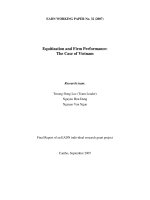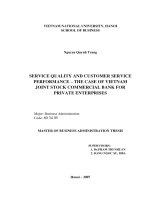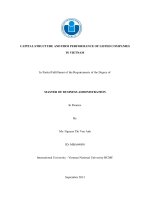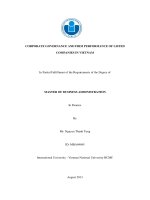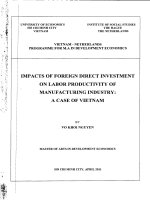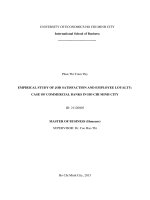Foreign ownership and firm performance case of vietnam
Bạn đang xem bản rút gọn của tài liệu. Xem và tải ngay bản đầy đủ của tài liệu tại đây (477.51 KB, 54 trang )
MINISTRY OF EDUCATION AND TRAINING
UNIVERSITY OF ECONOMICS HOCHIMINH CITY
-----o0o-----
NGUYỄN THỊ THANH TÂM
FOREIGN OWNERSHIP AND
FIRM PERFORMANCE: CASE OF VIETNAM
MAJOR: BUSINESS ADMINISTRATION
MAJOR CODE: 60.34.05
MASTER THESIS
SUPERVISOR: Dr. VÕ XUÂN VINH
HO CHI MINH CITY, 2012
i
ACKNOWLEDGEMENT
I would like to express my greatest gratitude to my supervisor, Dr. Võ
Xuân Vinh, for his continuous support for the thesis, from initial advice
in the early stages of conceptual inception and through ongoing advices
and encouragement to this day, without which this research would hardly
have been completed.
I am grateful to the Examination Committee (Professor Nguyễn Đông
Phong, Dr. Nguyễn Trọng Hoài, Dr. Nguyễn Đình Thọ, Dr. Nguyễn Văn
Ngãi, and Dr. Nguyễn Thị Mai Trang) for their valuable advices to make
my thesis improved.
I would like to thank my professors at Faculty of Business Administration
and Postgraduate Faculty, University of Economics Ho Chi Minh City for
their teaching, guidance and support during my MBA course.
I owe my sincere thanks to my classmates for their encouragement and a
special thank of mine goes to my class monitor, Bùi Hồng Thu, for his
great assistance in collecting data for this thesis and for his guidance in
econometrics respects.
I wish to thank my family for their unconditional support and
encouragement during my MBA course.
ii
ABSTRACT
Purpose – The thesis aims to investigate the relationship between foreign
ownership and firm performance on a selective sample of firms listed on
Hochiminh Stock Exchange for period 2007-2010.
Methodology – The thesis applies the Ordinary Least Squares method to
run multiple regressions on the whole sample and on each level of foreign
ownership in order to give a closer view at the relationship between
foreign ownership and firm performance.
Findings – The empirical results show a significant correlation between
foreign ownership and firm performance, measured by Tobin’s Q. The
regressions on each level of foreign ownership indicate that foreign
ownership was found to be significantly positive correlated with Tobin’s
Q when foreigners own between 5% and 20% of shares in firms, while a
negative correlation occurs where foreign holdings are more than 20%,
specially considerably negative where the level is more than 40%; and
there is no significant relationship between the two variables where
foreigners own less than 5% of shares.
Originality/Value – The thesis tries to analyze how foreign ownership
affects firm performance and suggests that Vietnamese business owners
should take a scrutiny on benefits and costs of foreign investment.
Key words – Foreign ownership, firm performance.
iii
TABLE OF CONTENTS
ACKNOWLEDGEMENT ..................................................................... i
ABSTRACT ........................................................................................ ii
LIST OF TABLES ............................................................................... iv
LIST OF FIGURES ...............................................................................v
ABBREVIATIONS .............................................................................. vi
1. INTRODUCTION ............................................................................1
1.1. Background ..................................................................... 1
1.2. Purpose ............................................................................ 3
1.3. Scope................................................................................ 4
1.4. Research questions ......................................................... 5
1.5. Structure ......................................................................... 5
2. LITERATURE REVIEW.................................................................6
3. METHODOLOGY ......................................................................... 16
3.1. Data ............................................................................... 16
3.2. The model ...................................................................... 16
3.3. Statistical Method ......................................................... 22
4. DATA ANALYSIS .......................................................................... 23
4.1. Descriptive Statistics ..................................................... 23
4.2. Correlations .................................................................. 25
4.3. Regression Results ........................................................ 26
5. CONCLUSION ............................................................................... 37
REFERENCES .................................................................................... 39
APPENDICES ...................................................................................... 43
iv
LIST OF TABLES
Table 4.1. Descriptive Statistics ..........................................................................23
Table 4.2. Correlation matrix ...............................................................................25
Table 4.3. Ordinary Least Squares Regression Results.................................27
v
LIST OF FIGURES
Figure 1.1. FDI contributions for the period 2006- 2011 ..........................2
Figure 1.2. FDI registered and implemented capital for the period
2006-2011 ................................................................................................3
vi
ABBREVIATIONS
debt_asset
Financial Leverage
FDI
Foreign Direct Investments
foreing_own
Foreign Ownership
GDP
Gross Domestic Product
HoSE
Hochiminh Stock Exchange
ln_asset
Firm Size
OLS
Ordinary Least Squares
ROA
Return on Asset
ROE
Return on Equity
R&D
Research and Development
Q
Tobin’s Q (Firm Performance)
2SLS
Two Stage Least Squares
1
1.
INTRODUCTION
1.1.
Background
The relationship between ownership structure and firm performance has
been examined since decades. Some researches shows no effect of
ownership structure on firm performance, while others indicate there is a
correlation between these two factors.
Demsetz (1983) argues that there should be no relationship between
ownership structure and firm performance. Pursuing this argument
empirically, Demsetz and Lehn (1985) find no significant correlation
between profit rates and various measures of ownership concentration in
a sample of 511 United States companies using 1980 data. Himmelberg
et al (1999) extend the Demsetz and Lehn (1985) study by adding new
variables to explain the variation in the ownership structure. Ownership
structure is measured by shareholdings of insiders (officers plus
directors). Firm performance measure is Tobin’s Q. They employ the
capital-to sales, R&D-to-sales, advertising-to-sales, and operating
income-to-sales ratios as instrumental variables. Controlling for these
variables and fixed firm effects, they find that changes in ownership
holdings have no significant impact on performance. Demsetz and
Villalonga (2001) continue to examine the ownership-performance
relation by treating ownership structure as an endogenous variable and as
an amalgam of shareholdings owned by persons with different interests.
By estimating a two-equation model for United States firms, their
evidence shows that performance (defined as Tobin’s Q or the accounting
profit rate) is not found to be influenced by ownership (defined as
2
managerial ownership (Chief Executive Officers, board of directors, top
management) or ownership by the five largest shareholders).
Despite the fact that Demsetz and Lehn (1985), Himmelberg et al (1999),
and Demsetz and Villalonga (2001) find no significant correlation
between ownership structure and firm performance, series of subsequent
researches, which had been done and built on the Demsetz heritage, prove
the converse results.
For instance, Andersson et al (2004) find that
dispersed ownership is associated with worse performance when
examining firms listed on Sweden Stock Exchange. A significant
negative relationship is also found by Lee and Chuang (2009) when
investigating the relation between insiders and corporate performance of
Taiwanese firms.
In line with this, Fishman et al (2005) find that
managerial ownership impacts negatively on performance.
This is
opposite to the findings reported by Drakos and Bekiris (2010), where
managerial ownership is found to be significantly positive correlated with
Tobin’s Q.
Figure 1.1. FDI contributions for the period 2006-2011
%
35
30
25
20
15
10
5
0
29.8
16.98
17.96
16.3
16
2006
2007
FDI contribution to GDP
25.7
25.8
26
18.43
18.33
18.72
19
2008
2009
2010
2011
Year
FDI contribution to the total national investments
(Source: Foreign Investment Department, Ministry of Planning and Investment)
3
Figure 1.2. FDI registered and implemented capital for the period 2006-2011
(Source: Foreign Investment Department, Ministry of Planning and Investment)
As a part of ownership structure, foreign ownership plays an important
role. In Vietnam, foreign investments contribute considerably to Vietnam
economy.
Figure 1.1. and Figure 1.2. indicate that FDI implemented capital
continuously increases during the period 2006-2011. FDI implemented
capital in 2011 reaches 11 billion USD, which contributes 26% to the
national investments and 19% to GDP. Companies with foreign capital
participation are a form of FDI. Foreign investors bring to the receiving
companies some benefits, such as solid financial sources, modern
technology, and management skills. To some extent, foreign ownership
should have impact on firm performance.
1.2.
Purpose
The relation between ownership structure and firm performance remains
controversial in numerous studies in diverse economies. For instance,
4
Demsetz (1983), Demsetz and Lehn (1985), McConnell and Servaes
(1990), Himmelberg et al (1999), and Demsetz and Villalonga (2001)
conduct survey in United States of America; Mudambi and Nicosia
(1998) and Dinga et al (2009) study the case of United Kingdom; the
studies of Welch (2003) and Fishman et al (2005) are based on Australia
data; Kuznetsov and Muravyev (2001) examine the ownershipperformance relationship in Russia; and other empirical analysis are
reported by Andersson et al (2004) and Bandick (2005) in Sweden, AlShiab and Abu-Tapanjeh (2005) in Jordan, by Aydin et al (2007) in
Turkey, by Kapopoulos and Lazaretou (2007) in Greek, by Lee and
Chuang (2009) in Taiwan, by Hu and Zhou (2006) and Hess et al (2010)
in China, by Drakos and Bekiris (2010) in Egypt, by Priya and
Shanmughan (2011) in India, by Gelubcke (2011) in Germany, and by
Pervan et al (2012) in Croatia.
Nonetheless, there have been, to the best of my knowledge, very few
studies on the topic of foreign ownership and firm performance relation
in Vietnam. The purpose of this study is to examine whether there exists a
relationship between foreign ownership and corporate performance of the
companies listed on HoSE and to explore how foreign ownership affects
firm performance.
1.3.
Scope
The present thesis employs a selected sample of the companies listed on
HoSE for the period 2007-2010.
5
The thesis is limited to examine the impact of foreign ownership on firm
performance without taking into account the relation between the origin
of foreign investors and firm performance.
The thesis does not examine the relationship between firm performance
and foreign investors who hold managerial positions in the companies.
1.4.
Research questions
To explore the relationship between foreign ownership and firm
performance, the two specific research questions are set as follows.
• Is there a relationship between foreign ownership and firm
performance of HoSE listed companies?
• Does foreign ownership affect positively firm performance?
1.5.
Structure
The thesis does not follow the conventional way where each section is
outlined into chapter but into section. The remainder of this thesis is
organized as follows. The literature review section summarizes previous
studies on this topic. The data and the methodology employed in the
thesis are presented in the following section. The analysis section
introduces the empirical findings. The final section concludes the thesis.
6
2.
LITERATURE REVIEW
Though the ownership-performance relationship has been the subject of
voluminous researches, no agreement has been reached.
Some studies find no link between ownership structure and firm
performance, namely Demsetz and Lehn (1985), Himmelberg et al
(1999), Demsetz and Villalonga (2001), Welch (2003), Klungland and
Sunde (2009), and Mihai (2012).
Demsetz and Lehn (1985) apply the OLS method to run statistical
analysis over 511 firms in United States of America, for the time period
1976-1980, and find no significant relationship between ownership
concentration and accounting profit rates. This cross-sectional analysis is
then extended by Himmelberg et al (1999) by adding new variables to
explain the variation in ownership structure.
Himmelberg et al (1999) find that managerial ownership and firm
performance measured by Tobin’s Q are endogenously determined by
firm specific factors and key variables in the firm’s contracting
environment. Controlling both for observed firm characteristics and firm
fixed effects, they conclude that managerial ownership does not affect
firm performance. However, examining the endogeneity of ownership
structure by using instrumental variables, they find a quadratic
relationship between ownership and performance. Himmelberg et al
(1999) conclude that previous works are unable to examine the nonobservable heterogeneity, and hence any relationship detected might
result from spurious correlations.
7
Demsetz and Villalonga (2001) investigate the link of ownership
structure and corporate performance, but in a new way, where ownership
is made multi-dimensional and treated as an endogenous variable.
Conducting both OLS regression analysis and 2SLS test, over a sample of
223 firms quoted in the Fortune 500 list, for the time-period 1976-1980,
they affirm that there was no significant relation between ownership
structure and firm performance.
Applying and developing the models by Demsetz and Villalonga (2001),
Welch (2003) examine the connection of ownership structure with firm
performance, on a sample of 114 public companies listed on the
Australian Stock Exchange, for the time-period 1999-2000. The OLS
results show that ownership is significant in explaining performance.
However, when endogeneity is taken into account, the 2SLS regression
provides no statistical dependence of ownership on performance.
Additionally, the results from a generalized nonlinear model illustrate
limited evidence of a nonlinear relationship between managerial share
ownership and firm performance.
The similar results are found in the study of Klungland and Sunde (2009),
on a large sample of quarterly data from non-financial Norwegian
companies listed on the Oslo Stock Exchange in the period 2001-2007.
Using OLS analysis, Klungland and Sunde (2009) find a significant
negative relation between ownership concentration and firm performance,
measured by Tobin’s Q. Nevertheless, when controlling for fixed firm
effects, there is no significant relationship. Using the method of
8
instrument variables (2SLS) to account for endogeneity of ownership
structure, Klungland and Sunde (2009) find that the choice of instrument
highly affects the significance of the results. Since the results obtained
from using instrument variables are questionably driven by weak
instruments,
Klungland
(econometrically)
that
and
Sunde
ownership
(2009)
concentration
cannot
conclude
influences
firm
performance.
Mihai (2012) employs linear regression analysis to investigate whether
the foreign equity is associated with better performance in the case of 63
listed Romanian companies on the Bucharest Stock Exchange. The
outcome of the study suggests that there is no significant link between
firm performance and the existence of foreign capital.
In contrast to the above-mentioned studies, various empirical analyses
prove the reverse, for instance, Forsyth and Dwyer (1968), McConnell
and Servaes (1990), Cho (1998), Mudambi and Nicosia (1998), Aitken
and Harrison (1999), Wan (1999), Kuznetsov and Muravyev (2001), Park
(2001), Andersson et al (2004), Grant and Kirchmaier (2004), Jiang
(2004), Al-Shiab and Abu-Tapanjeh (2005), Fishman et al (2005), Hu
and Zhou (2006), Lisboa and Esperanca (2006), Alonso-Bonis and
Andrés-Alonso (2007), Aydin et al (2007), Farooque et al (2007),
Kapopoulos and Lazaretou (2007), Szép (2007), Yasar and Paul (2007),
Hake (2008), Laurenceson and Qin (2008), Lee (2008), Abidin et al
(2009), Bilyk (2009), Burker et al (2009), Cornett et al (2009), Dinga et
al (2009), Ghahroudi (2009), Lee and Chuang (2009), Drakos and Bekiris
9
(2010), Hess et al (2010), Gelubcke (2011), Priya and Shanmughan
(2011), and Pervan et al (2012).
McConnell and Servaes (1990) investigate the relation between Tobin’s
Q and the structure of equity ownership for a sample of 1,173 firms for
1976, and 1,093 firms for 1986. They find a significant curvilinear
relation between Q and the fraction of common stock owned by corporate
insiders. They also found a significant positive relation between Q and
the fraction of shares owned by institutional investors.
Cho (1998) uses a cross section of 326 manufacturing firms on Fortune
500 in 1991, and finds a significant relation between insider ownership
and corporate value, where corporate is measured by Tobin’s Q. He also
finds a similar non-monotonic relation between insider ownership and
investment.
Therefore, based on OLS analysis, ownership structure
affects investment and corporate value. However, when he estimates a
simultaneous equations system of ownership structure, investment, and
corporate value, the results show that investments affect firm
performance, which in turn affects ownership structure, but not vice
versa.
The study of Andersson et al (2004) on 87 Sweden companies indicates
that companies with a dispersed ownership structure are associated with
worse performance regarding stock return, ROA, and ROE, but are highly
valued relating to Tobin’s Q. The similar findings from Kapopoulos and
Lazaretou (2007), who follow the model of Demsetz and Villalonga
(2001) to conduct a research on a sample of 175 Greek firms. By
10
comparing OLS estimates to 2SLS estimates, empirical findings indicate
that there exists a linear positive relationship between firm performance
and ownership structure. Specifically, the study reveals that managerial
shareholdings and important shareholdings positively influence Tobin’s
Q; and that higher firm profitability required a less diffused ownership.
These findings were contradictory to Demsetz (1983)’s arguments: As
the number of shareholders increases, the wealth of each will depend less
on the success of the firm. But this carries no implication of a resulting
reduction in the value of the firm. Indeed, profit maximization may
require a diffuse ownership structure (Demsetz (1983), p.386). Recently,
Pervan et al (2012) support these arguments of Demsetz (1983) when
analyzing the relationship between firm performance (ROA) and firm
ownership (ownership concentration and type) on a sample of 1430 listed
Croatian firms for the period 2003-2010. Their empirical findings
indicate that ownership concentration is negatively related with
performance, for instance, firms with dispersed ownership perform better
than firms with concentrated ownership.
In addition, they find that
foreign controlled firms achieve higher level of profitability than
domestically controlled firms.
Another view on the impact of ownership structure on firm performance
from Fishman et al (2005), who examine this relationship by using data
of 50 companies listed on Australian Stock Exchange over the period
2002-2003, based on the models by Demsetz and Villalonga (2001) and
Welch (2003) in Australian environment. The OLS results illustrate that
no relationship between ownership structure and Tobin’s Q exists, while
the 2SLS results indicate that Tobin’s Q has a significantly negative
11
impact on the level of managerial ownership. To further investigate this
relationship, a three-equation model is developed and the findings
indicate that managerial ownership impacts negatively on firm
performance.
Al-Shiab and Abu-Tapanjeh (2005) have the similar
conclusion when examining the impact of ownership structure on firm
performance in 50 of the largest Jordanian Industrial Companies listed on
Amman Stock Exchange, over the period 1996-2002. Controlling for
capital structure, firm size, and sales growth, the OLS regression results
show a non-linear and significant effect of ownership concentration on
market-based measure (namely, market-to-book-value of equity), but
negative effect on accounting-based measure, (namely ROA).
The
negative correlation between ownership and corporate performance is
similarly found in the study of Lee and Chuang (2009). Examining on
the ten-year (1994-2003) panel data of 569 Taiwanese listed companies,
the empirical findings reveal that the ratio of mortgaged/pledged shares of
directors and supervisors and firm performance constitute a significantly
negative correlation, and that government institutional ownership and
incorporated companies’ ownership are found to have a significant
negative impact on Tobin’s Q.
Besides applying three statistical
methods, such as OLS, fixed effects, and random effects methods, Lee
and Chuang (2009) employ the F-test, Lagrange Multiplier test and
Hausman test to determine the best method amongst the three. However,
Lee and Chuang (2009) do not discuss whether the variables in their
study are endogenously related.
A different approach regarding the impact of managerial ownership on
firm performance is suggested by Abidin et al (2009), who examine the
12
association between board structure and corporate performance, where
performance is defined as the value added efficiency of the firm’s
physical and intellectual resources rather than the more commonly used
Tobin’s Q or ROA.
Testing on a randomly selected sample of 75
companies listed on Bursa Malaysia, the study finds that board
composition and board size have a positive impact on firm performance,
while the effects of directors’ ownership and Chief Executive Officers
duality on the value added efficiency of firm’s total resource are not
established. The managerial ownership – corporate value relationship is
also discovered by Drakos and Bekiris (2010). Using a panel data of 146
firms quoted on the Athens Stock Exchange for the period 2000-2004 and
based on the model developed by Demsetz and Villalonga (2001), Drakos
and Bekiris (2010) estimate a system of two regression equations, in
which managerial ownership and corporate performance (Tobin’s Q) are
endogenous variables. The main finding of the study indicated that when
managerial ownership is treated as endogenous, this leads to a positive
impact on corporate value.
Government always plays an important and special role in its economy.
Accordingly, state-owned holdings have important and special impact on
the firm performance. This is the reason why the relationship between
state ownership and firm performance is investigated in the research of
Cornett et al (2009) and Hess et al (2010). Cornett et al (2009) examine
the performance differences between privately-owned and state-owned
banks in 16 Far East countries from 1989 through 2004 to see how
government ownership affects bank performance. The study uncovers
that state-owned banks operate less profitably, hold less core capital, and
13
have greater credit risk than privately-owned banks prior to 2001.
However, in the post-Asian financial crisis period 2001-2004, the stateowned banks’ performance is improved. Hess et al (2010) investigate the
effects of state ownership structure on firm values on Chinese listed firms
for the period 2000-2004. The authors use both OLS and 2SLS analysis,
which treats ownership concentration as endogenous. The study confirms
the U-shaped of the state ownership-performance relationship. This
implies that firms dominated by the various state players continue to
maintain a greater respect by the market and outperform those with lower
levels of state block-holdings. However, at lower levels of state
ownership, the firm value declines up to a reflection point of
approximately 35 per cent beyond which the positive affects of state
dominance take effect.
Regarding the relationship between foreign ownership and firm
performance, Aitken and Harrison (1999) use a panel of more than 4,000
Venezuelan plants between 1976 and 1989 and find that increases in
foreign equity participation are correlated with increases in productivity
for recipient plants with less than 50 employees. Another finding from
their study is that foreign investment negatively affects the productivity
of domestically owned plants. Aydin et al (2007) apply t-test statistics to
examine over all quoted firms on the Istanbul Stock Exchange for the
period 2003-2004. The results reveal that firms with foreign ownership
perform better than domestic owned ones in respect to ROAs. The similar
results are found in the research of Yasar and Paul (2007), when they
examine the performance effects of foreign ownership, from the
perspective of firms in five transition economies, namely Poland,
14
Moldova, Tajikistan, Uzbekistan, and Kyrgyz Republic in 2002. The
empirical findings indicate that foreign owned firms perform better than
domestic counterparts, namely higher productivity, capital intensity,
export and import shares, employment, and wages are found in firms with
foreign ownership. Bilyk (2009) investigates the effects of foreign
ownership on performance of 264 Ukrainian manufacturing companies in
2002-2006. Bilyk (2009) divides foreign ownership into two types,
namely foreign offshore and foreign non-offshore firms. When fixedeffects regression is estimated, no consistent relationship between foreign
ownership and performance is found. Nonetheless, when more detailed
classifications of foreign ownership are used, empirical results provide
the evidence that there is a positive effect of investment coming from
foreign investors on firms’ profitability in Ukraine. Recently, Priya and
Shanmughan (2011) use ownership structure of 425 Indian firms over the
period 2003-2009 to examine whether differences in ownership structure
can explain their differences in performance. The empirical findings
suggest foreign ownership relates positively to firm performance
measured by Tobin’s Q and ROA. These above-mentioned findings are
opposite to those reported by Mihai (2012), who finds that there is no
significant link between firm performance and the existence of foreign
capital when investigating the foreign ownership-performance relation on
a sample of 63 Romanian listed companies for the period 2000-2010,
where ROA and ROE are used as measures of financial and economic
performance. This indicates that not all cases prove the theory of foreign
investment by Hill (2009). FDI recipient economy can benefit capital
supplies, modern technologies, and management resources, which boost
the host country’s economic growth (Hill (2009)).
15
Trying to explain about discrepancies amongst researches regarding the
ownership-performance relation, Hu and Izumida (2008) believe that the
important reason was the realities of corporate governance environments
in which firms were embedded. The disagreement was also owing to
model specification and estimating technique applied. Moreover, variable
measurements and data issues could explain partially the differences.
16
3.
METHODOLOGY
3.1.
Data
The data used for this thesis was collected from the website
www.cophieu68.com1. It consisted of a representative sample selected
from the total number of firms listed on the Hochiminh Stock Exchange
for the period 2007-2010. The data was collected during a period of four
years to avoid the bias when running regression on data collected for a
single year. The firms employed in this study must meet the following
criteria: The firms must be quoted on Hochiminh Stock Exchange at least
one year before the year of analysis; the proportion of foreign ownership
in the firms must be more than 0%; and the firms must be in operation in
the course of the thesis. With these criteria, the dataset included 83 firms
for the year of 2007, 125 for 2008, 151 for 2009, and 208 for 2010,
obtaining a total sample of 567 firm-years.
3.2.
The model
The past literature reveals that most of previous researches develop their
own models based on the model put forward by Demsetz and Villalonga
(2001). Similarly, the thesis applies the model built by Drakos and
Bekiris (2010), which is the most recently modified version of Demsetz
and Villalonga’s model. The model is presented as follows:
Q = β0 + β1foreign_own + β2ln_assets + β3debt_asset + ε
1
This website was selected to collect data for the thesis based on its sufficient and reliable information
for the model in this thesis.
17
Where:
Q
is Firm Performance, measured by Tobin’s Q values
for the period of 2007-2010.
Annual Tobin’s Q is calculated as the sum of total
year-end book value of debt and total year-end market
value of equity, divided by total year-end book value
of assets.
foreign_own
is Foreign Ownership, measured by percentage of
shares owned by foreigner in the firms.
ln_assets
is Firm Size, calculated by logarithm of total assets
debt_asset
is Leverage, followed the formula of Total year-end
debt over total year-end assets.
Firm Performance
There are two common measures of firm performance. One is accounting
measure and the other is market-value measure. Hirschey and Wichern
(1984) examine the relationship between accounting and market-value
measures on a 386-firm sample taken from the 1977 Fortune 500; and
they suggest both accounting and market-value measures can be used as
unique but imperfect indicators of profitability. Sauaia and Castro (2002)
use the Multinational Management Game to test whether Tobin’s Q is a
good indicator of a company’s performance. Comparing to the other
seven past performance indicators in the same (namely market-share;
return on sales; asset turnover; inventory turnover; return on assets; debt
18
to total assets; and return on equity), they find that companies that
achieved a better performance, are associated with a higher value of the
Tobin’s Q.
Existing researches commonly employs two measures of firm
performance, namely Tobin’s Q and accounting profit rates. These two
measures differ in some respects. Tobin’s Q is a forward-looking
performance measure, which takes investor psychology into account. In
contrast, accounting profit rate is backward-looking and unaffected by
market psychology. While accounting profit rates are affected by
accounting practices, such as the different methods applied to valuations
of tangible and intangible capital; Tobin’s Q distorts performance
comparisons of firms, because the numerator of Tobin’s Q (market value)
partly reflects a firm’s intangible assets, yet the denominator of Tobin’s Q
(replacement cost2) includes the firm’s tangible assets only (Demsetz and
Villalonga (2001); Hu and Izumida (2008)).
Since most economists have a better understanding of market constraints
than of accounting constraints, they are in favor of Tobin’s Q (Demsetz
and Villalonga (2001)). Moreover, accounting data is not thought as
eligible variables in measuring a firm’s performance in countries where
the accounting standards are imperfect, especially in developing countries
(Hu and Izumida (2008)). Accordingly, like most of previous researches
where the simple Tobin’s Q formula is commonly used, which is
calculated by summing up market value of equity and book value of total
2
Replacement cost of assets is the book value of a firm’s assets with inflation adjustments (Cho (1998),
p.107).

